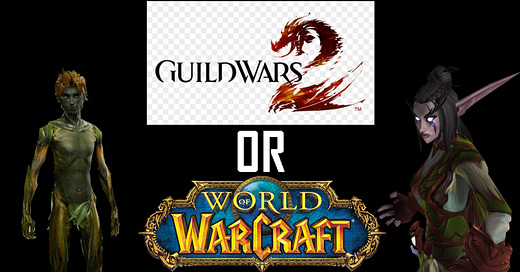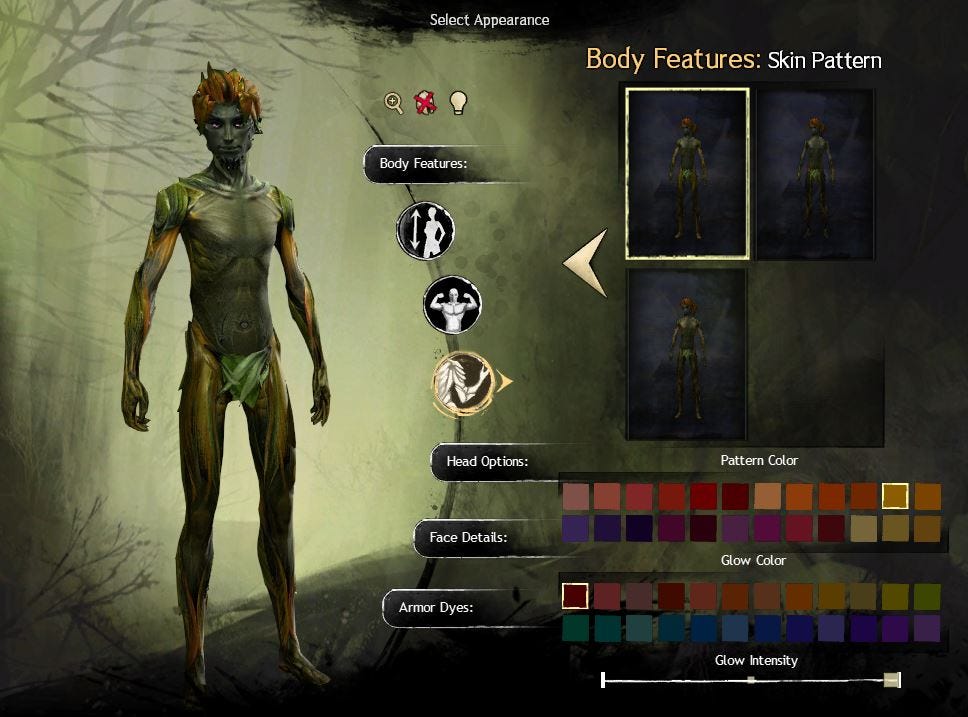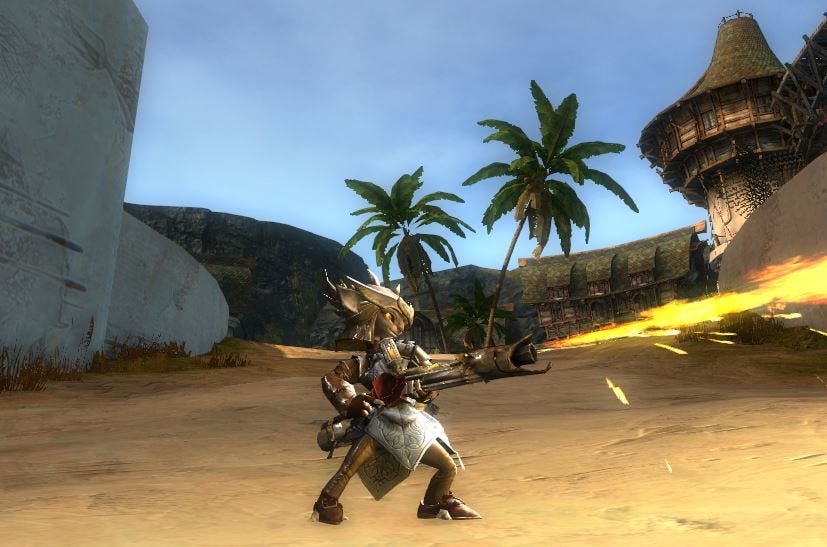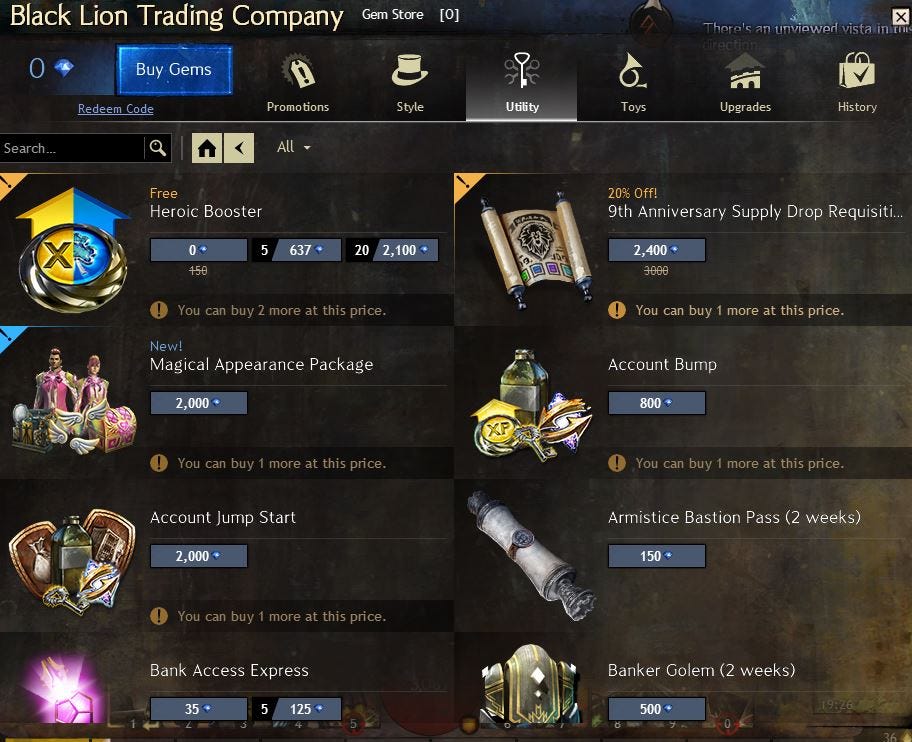Guild Wars 2: A Former WoW Player's First Impressions
With the mass exodus from World of Warcraft, there are many turning to other MMOs to fill the MMO shaped void within their heart. FFIV seems to be the piece most are finding to fill this vacuum. However, what are some MMO’s to replace WoW that are not filled with cat-girls and bunny-girls. Well, Guild Wars 2 may be just the thing you’re looking for. Guild Wars 2 was developed by ArenaNet and released on August 12, 2012
But before we dive into the details, I would like to preface that this first impressions is more inline for the wants and needs of a casual player rather than a hardcore raider. So, without further ado, let’s delve into the world of Tyria.
Character Creation -
First off, we begin with the objectively best feature of any RPG that can drain hours of our time, character creation. There are less races to pick from when concerning WoW, specifically 4 races down from 23. These races are the standard Human, the fearsome feline Charr, the botanical Sylvari, the formidable Norn, and the acutely intelligent Asuna (which remind me somewhat of house elves from Harry Potter). Whilst the appearance customiser allows for more personal freedom than WoW in that it allows for changes in physique and height, but it is still very limited. It can in no way be compared to a character with the likes of Black Desert of even Elder Scrolls Online. Instead, I would compare it more so with Star Wars: The Old Republic. Whilst I do like it when there is an extensive character customisation available, I can often find that quite overwhelming. So I think GW2 has hit a nice balance of providing distinct customisation options whilst also allowing for personalisation in other areas through sliders such as height, eye width and squint, etc.
As for classes (known as professions in GW2), there are three categories to choose from when concerning classes (all of which are unrestricted from boundaries like WoW places upon class choice like race). These categories, Soldier, Scholar, and Adventurer contain 3 classes each with their own various builds and playstyles. I myself choose to be Dobby with a gatling gun turret (an Asuna Engineer). It should be noted that one of the biggest defining features of each profession are their ‘profession mechanics’. These mechanics are key to understanding the kind of playstyle you can expect from the class.
Professions:
Soldier -
Guardian - Essentially the Paladin profession. They use passives called ‘virtues’ to determine their place within the Holy Trinity of DPS, Tanking, or Healing.
Warrior - Similar to Fury Warriors in WoW; Warriors use a resource called adrenaline to empower their abilities and deal out large amounts of burst damage after a period of build-up.
Revenant - an expansion exclusive class, the Revenant appears to be similar to a Guardian in that it uses passives to determine its playstyle.
Scholar -
Elementalist - Water. Earth. Fire. Air. These are the tools of the elementalist. Whilst in WoW, the Shaman is missing potential as it cannot only heal and deal damage, this is not the case with the elementalist. They can ‘attune’ to a given element and heal with water, crowd control with air, incinerate with fire, and defend with the bulwark of the earth.
Mesmer - Masters of the mind, the Mesmer can control illusions and trick enemies into diverting their attention elsewhere. They conjure clones and phantoms to attack and distract foes from yourself and allies alike.
Necromancer - The Necromancer seems like your standard necromancer, raising the dead, cursing enemies, and draining life force. However, they do have a distinct feature in their profession mechanic known as ‘death shroud’. This mechanic is empowered by ‘life force’ which can be drained from enemies. As a result of life force being converted into health as a result of death shroud, they are unusually resilient for a necromancer, at least in comparison to other games where necromancers feature.
Naturally, each profession also has an elite specialisation. More specifically one for each expansion, which after the release of the ‘End of Dragons’ expansion will be 3 specs each. These specs can drastically change the playstyle of the profession you are playing. For example, one of the Engineer elite specialisations is the Holosmith, which provides the Engineer with the ability to use a sword and many skills to go along with it. Considering the Engineer in the base game is entirely ranged, so this is quite the distinction.
All Elite specialisations as of writing:
Guardian-
Dragonhunter - allows Guardians to wield a longbow and use traps
Firebrand - converts the Guardian’s virtues into tomes and allows them to equip an axe.
Warrior -
Berserker - Puts your skills using burst damage into steroids mode.
Spellbreaker - More focused on removing buffs from enemies. Also allows for dual wielding of daggers.
Revenant -
Herald - focused on buffing allies
Renegade - Emphasis on ranged combat through the summoning of ‘warband members’ and also allowing for usage of the shortbow.
Engineer -
Scrapper - Allows for the Engineer to use a hammer and replaces the elite skill on the tool belt with the ‘Function Gyro’. This gyro can fulfill multiple functions, as the name would imply. It can be deployed to heal, defend, deal damage, and crowd control.
Holosmith - Allows for the Engineer to use a sword and has a new ‘photon forge’ mechanic. This photon forge allows the Holosmith to build up a resource called ‘heat’ which can be used to fuel skills to deal damage and crowd control. However, too much heat can cause damage to your character.
Thief -
Daredevil - Uses a staff to deal cone damage whilst also placing more emphasis on dodging.
Deadeye - Allows the thief to use a rifle and focuses on using ‘marks’ to weaken enemies by increasing their vulnerability. Similar to the Marksman Hunter in WoW.
Ranger -
Druid - Healing specialisation, the Druid spec allows the ranger to transform into a ‘celestial avatar’. When in this form, you unlock new skills to heal your enemies. The Druid also unlocks the ability to use a staff.
Soulbeast - Taking animal bonding to a whole new level, the Soulbeast literally merges with their pet to unlock new skills dependent on the pet they have bonded with.
Elementalist -
Tempest - The Tempest can ‘overload’ your current elemental attunement to cast a powerful spell akin to their current attunement.
Weaver - Allows the Elementalist to be in two elemental attunements at once to create new skills. Now the Weaver gains access to skills combining fire and water, air and earth, etc.
Mesmer -
Chronomancer - Perhaps one of the most misleading names as the Chronomancer does very little time magic. It uses passive traits/skills which make your able to move and cast faster. Furthermore, it’s profession mechanic is ‘shatter’ which blows up your clones to deal AOE damage. Very timey wimey.
Mirage - Uses their illusions to ‘ambush’ their prey. The Mirage is essentially an assassin that uses illusions.
Necromancer -
Reaper - Allows the Necromancer to bring out a greatsword and changes Death Shroud into ‘Reaper’s Shroud’, which brings greater emphasis on heavy melee damage.
Scourge - More focus on summoning shades which are fuelled by your life force instead of Death shroud, which is now gone.
Gameplay –
Blending the two types of combat often seen in MMOs, those being tab targeting like in WoW and action combat such as that of New World, instead GW2 uses what’s called ‘Mixed combat’. You don’t need a target to activate your abilities like in WoW, but they will instead lock onto the nearest target upon entering combat and change targets when you want to. Through this style, GW2 can maintain the standard means of combat in MMOs which allows for gameplay to be more focused on allowing players to determine and follow a rotation for their class or build. As for the action side of the combat, GW2 features a dodge mechanic which allows for bosses to have smaller cast times for the player to react to, which induces a faster paced combat. Personally, I still find this to be quite clunky as the animation is quite slow and drains a large portion of stamina, and when you have bosses that are casting abilities constantly, losing all your stamina after dodging twice or thrice makes me think as to what the point of dodge mechanic is? Ultimately, it’s just annoying and sometimes I even forget that it’s there. I think that ESO’s block and and dodge mechanic is better as it drains no-where no as much stamina, plus it is far faster.
Earlier, I mentioned Builds, well GW2 has an emphasis on allowing players to develop their own builds and play around with how they want to play with their class. Each class has a set of weapons that they can use each with their own weapon skills. Classes can augment these weapon skills using their own class skills, such as the engineer being able to use its flamethrower utility skills to give their guns incendiary properties for a time being. Speaking of utility skills, each class and their elite specialisations have a utility skill bar. These skills are pivotal in your build and will determine your playstyle alongside your weapon skills. However, whilst much like WoW there is a meta, there is still plenty of room within GW2 for large variations in your build. I always welcome the idea of multiple variations in playstyles even within a class-based system. However, skills or traits in other games can be quite overwhelming in number or simple stat boosts like in Path of Exile, but thankfully GW2 is not like this. Certain skills can completely change a class’s playstyle making personal exploration much more worthwhile.
You can find some build ideas here.
Concerning the difficulty of mobs within the open world, when fighting individual enemies you won’t really need to worry about your health and healing up after every fight like in WoW classic, but should you take on a horde of enemies at once, then you most certainly will need to be somewhat strategic in what abilities you use if you are to survive the onslaught you have brought upon yourself. There are also ‘veteran’ mobs found throughout the world which are comparable to elite mobs. Whilst they are soloable, you will still need to take care not to die. Nevertheless, the world unfortunately does not feel that dangerous. I really need to care about what I am fighting and how in the open world, unless it’s a veteran mob. After playing WoW classic, I really think that this can harm the community aspect of an MMO as players have to work together to overcome some quests. However, the presence of World Events of varying difficulty does mean that players still work together to overcome harder challenges in the world. The only problem with this is that it feels less personal as an individual player, so I still felt disconnected from the community.
World –
Speaking of the world itself, is it interesting to explore? Well, from my opinion, they see to have taken the worst elements of Ubisoft’s world design. The map is full of mindless collectathon-like activities, such as ‘vistas’ (the equivalent of towers) except they don’t show new areas of the map, you just have to go there or speak to a ‘scout’ NPC and they will show it all for you. There are also waypoints (for fast travel), hero challenges, and ‘points of interest’ (which ironically are of very little interest). There is some sense of exploration in that if you explore some little nooks and crannies you may find extra gathering resources or a hero challenge, but this is very insignificant. World of Warcraft has done exploration somewhat well in the past such as in the Mists of Pandaria and Warlords of Draenor expansion with hidden treasures. But Guild Wars 2 does very little of this, the map reveals almost everything for you upon speaking to a scout NPC.
However, Tyria does have some good elements. There is a level scaling system in place which allows for higher levels players to continue doing content which was intended for lower-level players at the difficulty it was intended. You still receive EXP and rewards comparable as to what you would receive if you were doing current content. In some areas, lower level players can even get scaled up. This is especially important in PVP as you can be scaled up to max level (level 80) to participate. However, you will not have your abilities and players whom have higher level gear will have a much bigger advantage. Regardless, I think that this is great for keeping the old world alive as it establishes the precedent that the world is alive and kicking and that there is plenty to do at end game due to a thriving community.
If you want to level up at a decent pace, then you will want to do these world events. Doing a zone’s tasks (the equivalent of quests) will not be enough to level you up through the zone. So, you will want to do as many world events as you can. These events could be escorting a supply caravan, defending an outpost, disarming traps, or even in one event I had to solve a puzzle using some actual maths. I totally didn’t forget how to calculate percentages and perimeters, I SWEAR!
Concerning a zone’s story, it is extremely basic unfortunately. Even more basic than some of WoW’s quests. There is a reason why they are called tasks. They can all be equated to the following exchange:
· Task giver - “hey, adventurer, we need some help over here solving this problem”
· Player – “sure”.
· *solves problem
· Task giver- “Thanks, adventurer, we are truly grateful. See ya.”
There are no continuing storylines within a zone, making these areas as bland as a traffic jam.
Instead of storylines, GW2 has its World Events as the primary means of levelling. These world events are dynamic in that they would entail for example defending a town from centaurs. Fail the event, another event will spawn to take the town back from the centaurs. Whilst this is certainly a cool and interesting system, I certainly think it greatly detracts from the game given that the world and the lore of the game actually seems interesting and there’s so much lost potential for some very exciting story telling to be had, especially considering the quality of the personal story that I experienced early on set a good first impressions.
One of the best things about GW2 that I have experienced is the personal story. At character creation, there are two RP choices that you need to pick. For me, as an Asuna, it was my College (I picked the College of Dynamics) and my first invention (the infinity ball). Whatever you picked will determine what questlines you experience in first two chapters of the personal story. I found these questlines to actually be interesting and compelling with interesting characters. They were certainly more interesting than some of WoW questlines, plus they took into consideration your choices. Furthermore, at one point in the second questline, I got to choose how to approach one of the quests. I choose to charm my way into a facility, which increased my charisma stat so that I could use it other tasks and stories elsewhere without a fight. You don’t see this kind of storytelling often in MMOs, perhaps the most notable exception being SWTOR, which I think is a great shame, but I digress. GW2 has let itself down somewhat by not placing more emphasis on storylines throughout the game and instead focusing on World Events as the main means of levelling.
Presentation (Artstyle, UI, and Audio) –
In terms of art style, GW2 is boring in comparison to WoW. Even in the most haunted and dark of places, WoW’s art never fails to bring life to my soul. There is such as distinct aesthetic to it that never fails to please. I wish I could say this about GW2, but there has yet to be one place in GW2 that makes me feel like a joyful Quokka. If you don’t know what a Quokka is, please Google them, they are adorable. The closest places that have come to making me feel happy are areas associated with the Sylvari because of their emphasis on magical plants and the saturated greenery they live amongst. So, the graphics are boring, but what about the Voice acting and Audio.
Unlike WoW, much of Guild Wars 2 is voice acted, and I must say, It’s surprisingly good at times. The voice actors for the Asuna certainly managed to capture arrogance and the self-gratifying nature of the Asuna race, and the Sylvari certainly sound elegant and mystical. However, I do find that the likes of the Norn and Charr are quite boring. The former does not sound Norse whatsoever and the Charr just have deep voices. As for the humans, it’s their job to be boring, so they are doing it perfectly.
Whether it’s large and booming orchestras or quite ambience, the music in a game is a defining feature of the experience. Unfortunately, the music in GW2 is nothing special. It doesn’t make me feel anything. The music in WoW, be it in the Barrens, Grizzly Hills, or Westfall, all zones make you feel something different be it loneliness, tranquility, or fear. They all set an atmosphere. It’s a shame that GW2’s atmosphere is so thin.
As for the UI, it’s minimialistic and has very little clutter making it very easy to understand. However, the lack of ability to customise its layout can be somewhat annoying to some.
Store –
The store, the blight of all games, is very much present in GW2 and causes the same issues in this game as the WoW store does and more. The GW2 ‘Black Lion Trading Company’ provides the means of exp boosts, bank space, level boosts, mount skins, outfits, and more. The worst thing though, is the equivalent of the WoW token, gems. The store uses gems as a form of currency. These gems can be bought with gold or real money. However, there is also an exchange system wherein Gems can be exchanged for in-game gold, which can in turn be used to buy end-game gear. This essentially makes the game in-directly pay-to-win. Because of this, GW2 has immediately downplayed any form of investment I put into this game. If you are ok with this, I hope you enjoy the game, but knowing this, I don’t feel right investing any more time into GW2.
Conclusion – GW2 has an interesting world with an interesting set of systems allowing for a level of player freedom in how they want to play the game. However, it lets itself down when some systems cause a detraction from great elements of the game, such as the story. Furthermore, the lack of a distinct art style makes the game look dated and as such, there is very little to make it look appealing from a visual perspective. Lastly, the store is egregious and the cementing factor for me as to whether the game is worth investing my time into. If you are looking for a good story in GW2, only expect it in small doses; if you are looking for a fulfilling endgame, the pay-to-win store makes it feel unfulfilling, and whilst the World feels alive, I still feel disconnected. GW2 is not the game for me, and certainly not the game to replace WoW.






